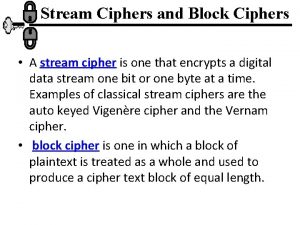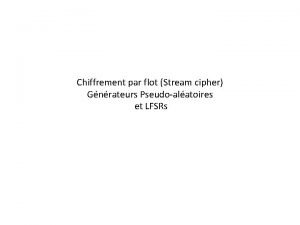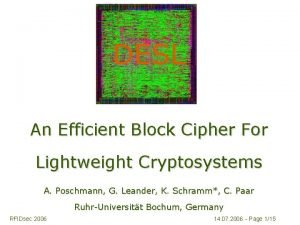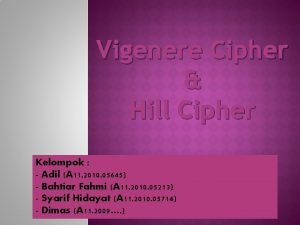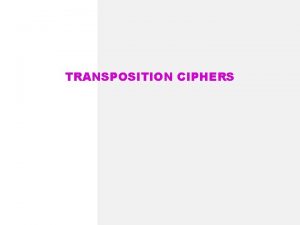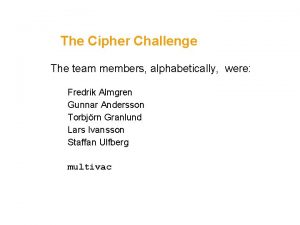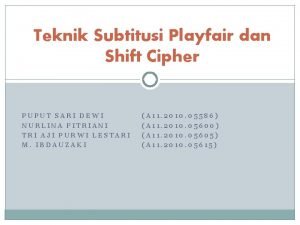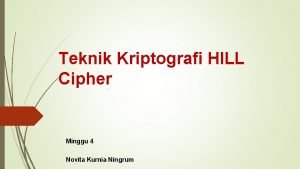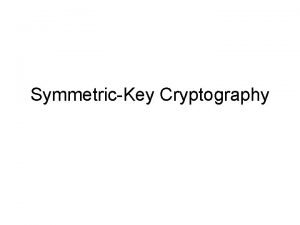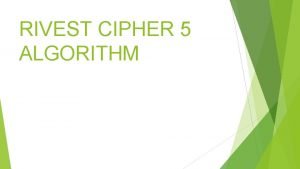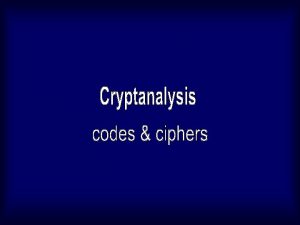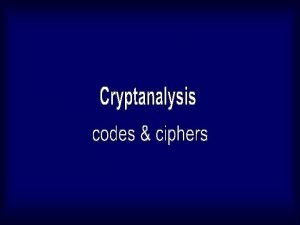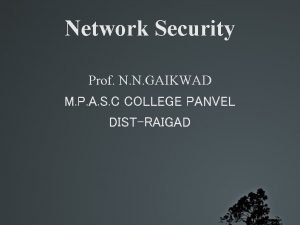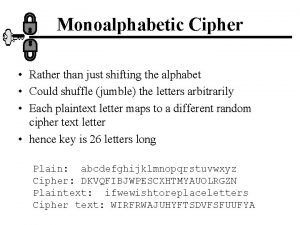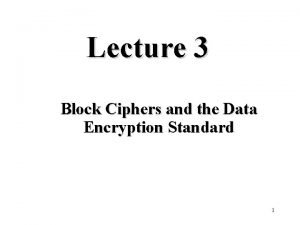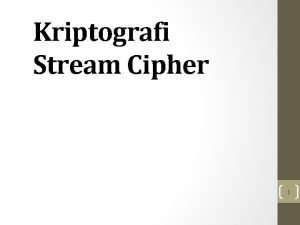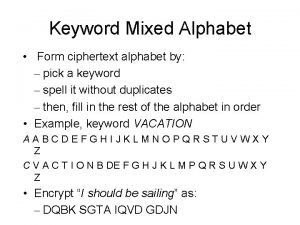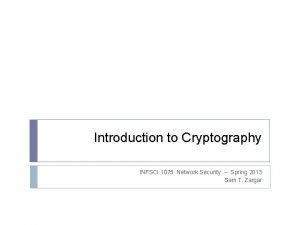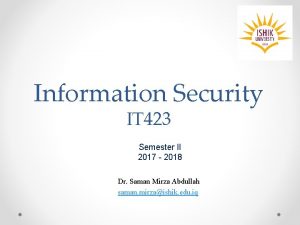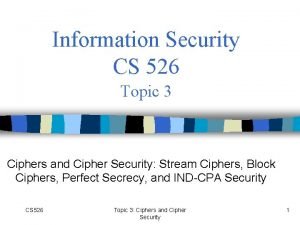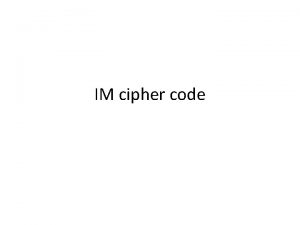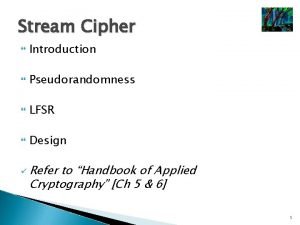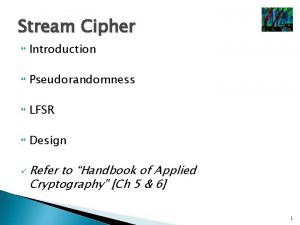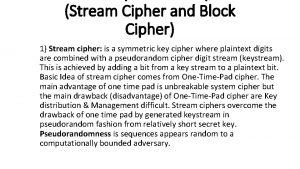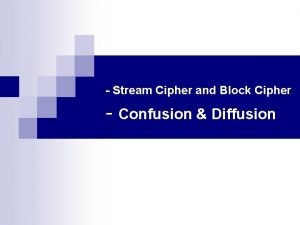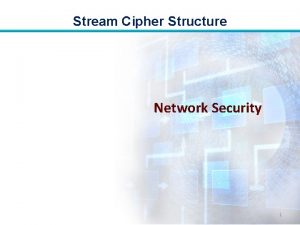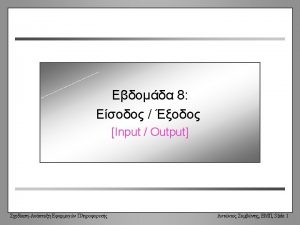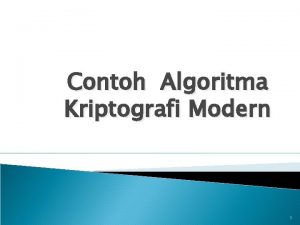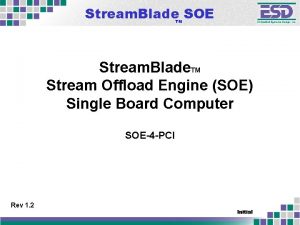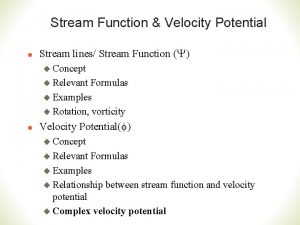Stream Cipher q Introduction q Pseudorandomness q LFSR









![Notation of LFSR § Notation: < L, C[D]> where connection poly. C[D] = 1 Notation of LFSR § Notation: < L, C[D]> where connection poly. C[D] = 1](https://slidetodoc.com/presentation_image_h2/edce33421c6ae523b9009932d04b4ddc/image-10.jpg)























- Slides: 33

Stream Cipher q Introduction q Pseudorandomness q LFSR q Design ü Refer to “Handbook of Applied Cryptography” [Ch 5 & 6] 1 © Information Security Group, ICU

Stream Cipher q. Introduction • Originate from one-time pad • bit-by-bit Exor with pt and key stream (ci = mi zi) • Encryption = Decryption --> Symmetric • Use LFSR (Linear Feedback Shift Register) • (external) Synchronous or self-synchronous q. Properties • Faster and Low Complexity in H/W • Security measure : Period of key stream, LC(Linear Complexity), Statistical properties • Vast amounts of theoretical knowledge • Proprietary and Confidential for Military 2 © Information Security Group, ICU

Sequence q. Def) ms=s 0, s 1, … : infinite seq. , msn=s 0, s 1, …, sn-1: n term of s mif si = si+n for all i >=0, s is periodic seq. having period n. mrun : subsequence of consecutive ‘ 0’(gap) or consecutive ‘ 1’(block) 3 © Information Security Group, ICU

Pseudorandomness 4 © Information Security Group, ICU

Golomb’s postulates(I) s. N : periodic seq. of period N (1) For a cycle of s. N, 0~1 balanceness, i. e, | #{si=1} - #{sj=0} | =<1 (2) For a cycle of s. N, half the runs have length 1, 1/4 have the length 2, …, etc. (3) Autocorrelation* function is two-valued * Measuring similarity between original and t-shifted sequences ** A sequence satisfying them is called Pseudo-Noise(PN) sequence. 5 © Information Security Group, ICU

Golomb’s postulates(II) (Ex) s 15 = 0, 1, 1, 0, 0, 0, 1, 1, 0, 1 (1) #{0} = 7, #{1}=8 (why ? ) (2) 8 runs, 4 runs with length 1 (2 gaps, 2 blocks), 2 runs with length 2 (1 gap, 1 block), 1 run with length 3 (1 gap), 1 run with length 4 (1 block) (3) Autocorrelation function, C(0)=1, C(t)= -1/15 Thus, PN-seq. 6 © Information Security Group, ICU

Statistical Randomness q Five Basic Tests m. Frequency Test (monobit) m. Serial Test (twobit; Overlapping is allowed) m. Poker Test (Frequency of m-bit subsequences) m. Runs Test m. Autocorrelation Test q Others m. Spectral Test m. Linear Complexity Profile m. Quadratic Complexity m. Universal Test 7 © Information Security Group, ICU

Statistical Test by FIPS 140 -1 For a given 20, 000 bit sample seq. (I) monobit test : The number of ‘ 1’=n 1, 9, 654 < n 1 < 10, 346 (2) poker test : m=4, 1. 03 < X 3 < 57. 4 (3) runs test : for length 1 i 6 (4) long run test : no run greater than 34 8 © Information Security Group, ICU

LFSR 9 © Information Security Group, ICU
![Notation of LFSR Notation L CD where connection poly CD 1 Notation of LFSR § Notation: < L, C[D]> where connection poly. C[D] = 1](https://slidetodoc.com/presentation_image_h2/edce33421c6ae523b9009932d04b4ddc/image-10.jpg)
Notation of LFSR § Notation: < L, C[D]> where connection poly. C[D] = 1 + c 1 D + c 2 D 2 + …+c. LDL Z 2[D] § If c. L=1, {i. e. , deg{C[D]}=L}, C[D] is called a nonsingular polynomial. § If initial stage is [s. L-1, … , s 1, s 0], output seq. s 0, s 1, … sj = (c 1 s j-1 + c 2 s j-2 + … + c Ls j-L) mod 2 , j L (Ex) <4, 1 + D 4> , 0 = [0, 1, 1, 0] s 4=s 3+s 0 § Finite State Machine t D 3 D 2 0 1 2 3 4 5 6 7 0 0 1 0 0 0 1 1 1 0 0 0 1 D 0 1 1 0 0 0 0 (6) 1 (3) 1 (9) 0 (4) 0 (2) 1 (1) 0 (8) 0 (12) t D 3 D 2 D 1 D 0 8 1 1 1 0 (14) 9 1 1 (15) 10 0 1 1 1 (7) 11 1 0 1 1 (11) 12 0 1 (5) 13 1 0 (10) 14 1 1 0 1 (13) 15 0 1 1 0 (6) Output Stage 3 D 3 Stage 2 D 2 Stage 1 D 1 Stage 0 D 0 Output seq. = 0, 1, 1, 0, 0, 0, 1, 1, 0, 1, 0 10 © Information Security Group, ICU

Properties of m-LFSR(I) q The period of the sequence from LFSR divides 2 L-1 q A polynomial f(x) is called a primitive polynomial if f(x) | xk -1 for k=2 L-1 not for smaller k • # of monic primitive poly = (2 m-1)/m in Z 2[x] where is Euler-phi ft. q If the connection polynomial is primitive, the period is 2 L-1 q Such sequence is called Maximum-length Shift Register Seq. , M –seq. and LFSR is called m-LFSR. 11 © Information Security Group, ICU

Primitive Polynomials m k(k 1, k 2, k 3) 2 3 4 5 6 7 8 9 10 11 1 2 1 1 6, 5, 1 4 3 2 12 13 14 15 16 17 18 19 20 21 7, 4, 3, 1 12, 11, 1 1 5, 3, 2 3 7 6, 5, 1 3 2 22 23 24 25 26 27 28 29 30 31 1 5 4, 3, 1 3 8, 7, 1 3 2 16, 15, 1 3 m k(k 1, k 2, k 3) 32 33 34 35 36 37 38 39 40 41 28, 27, 1 13 15, 14, 1 2 11 12, 10, 2 6, 5, 1 4 21, 19, 2 3 Primitive polynomial over Z 2: - xm+xk+1(trinomial) - xm + xk 1+xk 2+xk 3+1(pentanomial) 12 © Information Security Group, ICU

Properties of LFSR(II) q Well suited for H/W implementation q Produce seq. of large period q Good statistical properties q Readily analyzed by algebraic structure q Breakable by consecutive 2 * L sequence : depends on computing an inverse matrix whose complexity is O(L 3), L : length of LFSR. one LFSR is useless. 13 © Information Security Group, ICU

Linear Complexity(I) q (Def) Given an infinite sequence s, the shortest length of LFSR’s that generate s is called Linear Complexity q Using Berlekamp-Massey algorithm, LC is computed q (Properties of LC) s, t : binary seq. m For any n 1, 0 L(sn) n m L(sn) =0 iff sn is ‘ 0’ seq. of length n. m L(sn) =n iff sn=0, 0, …, 0, 1. m If s is periodic with period N, L(sn) N. m L(s t) L(s) + L(t) 14 © Information Security Group, ICU

Linear Complexity(II) q sn : random seq. from all seq. of length n q Expectation value of LC where B(n)=0 if even n, otherwise 0 For large n E(L(sn)) n/2 + 2/9 and Var(L(sn)) 86/81 q (Def) LCP (Linear Complexity Profile) Denote LN is LC of s. N=s 0, s 1, …s. N-1, L 2, … LN is LCP 15 © Information Security Group, ICU

Nonlinear FSR f ( s j-1, s j-2, …, s j-L) Sj Sj-1 Sj-L+2 Stage L-1 sj-L+1 Stage 1 S j-L Stage 0 Output f() : nonlinear ft 16 © Information Security Group, ICU

Design 17 © Information Security Group, ICU

Synchronous Stream Cipher(I) f : next state ft, i+1 = f( i , k), 0 : initial value g : keystream generating ft, zi = g ( i , k), k : key § § h : output ft, ci = h (zi, mi) , mi : pt, zi : key stream, ci: ct § i i+1 i f k f g h k g zi mi i+1 zi ci ci Encryption 18 h-1 Decryption mi © Information Security Group, ICU

Synchronous Stream Cipher(II) q Keystream is independent of pt and ct q Properties m Synchronization requirement m No error propagation m Active attack Ø Insertion, deletion or replay will lose synchronization Ø Change selected ciphertext digits Need to have integrity check mechanisms 19 © Information Security Group, ICU

Self-Synchronous Stream Cipher(I) § § § i = (ci-t , ci-t+1, …, ci-1), 0 = (c-t, c-t+1, …, c-1) : initial value g : keystream generating ft, zi = g ( i , k), k : key h : output ft, ci = h (zi, mi) , mi : pt, zi : keystream, ci : ct k g g zi mi h k zi ci ci Encryption h-1 mi Decryption 20 © Information Security Group, ICU

Self-Synchronous Stream Cipher(II) q Keystream is independent of pt and ct q Properties m. Self-Synchronization m. Limited error propagation m. Active attack Ø Difficult to detect insertion, deletion, or replay Ø Easy to find passive modification m. More diffusion more resistant against attacks based on plaintext redundancy 21 © Information Security Group, ICU

Nonlinear Combiner(I) LFSR 1 LFSR 2 f Keystream, z LFSR n Algebraic Normal Form (ANF) : mod. 2 sum of distinct m-th order product of its variable, 0 <= m <= n Ex) f(x 1, x 2, x 3, x 4, x 5)=1 + x 2+ x 3 + x 4 x 5 + x 1 x 2 x 3 x 4, deg(f) =4 22 © Information Security Group, ICU

Nonlinear Combiner(II) q Geffe generator LFSR 1 LFSR 2 x 1 x 2 Keystream, z LFSR 3 x 3 • f(x 1, x 2, x 3) = x 1 x 2 (1+x 2)x 3 = x 1 x 2 x 2 x 3 • p(z) : (2 L 1 -1) (2 L 2 -1)(2 L 3 -1) where L 1, L 2 and L 3 are relatively prime • L(z) = L 1 L 2 + L 1 L 3 + L 3 • Prob(z(t)=x 1(t)) =3/4 Correlation attack is possible ! 23 © Information Security Group, ICU

Nonlinear Combiner(III) q Summation generator Carry LFSR 1 LFSR 2 LFSR n If Li and Lj are pairwise relatively prime, then p(z) = i=1 n (2 Li -1) LC p(z) But vulnerable to the correlation attack of carry and 2 -adic span x 1 x 2 xn z, keystream 24 © Information Security Group, ICU

Clock-controlled generator(I) q Alternating step generator LFSR R 2 Clock z, keystream LFSR R 1 LFSR R 3 R 1 : de Brujin seq. of period 2 L 1 R 2, R 3 : m-seq s. t. , gcd(L 2, L 3)=1 p(z) = 2 L 1 (2 L 2 -1)(2 L 3 -1) L(z) : (L 2 + L 3) 2 L 1 -1 < L(z) <= (L 2+L 3) 2 L 1 m Best known attack is a divide-and-conquer attack on the control register R 1 in 2 L m L should be about 128 (de Brujin = maximal period) 25 © Information Security Group, ICU

Clock-controlled generator(II) q Shrinking generator LFSR R 1 ai Clock LFSR R 2 bi ai=1 ai=0 output bi discard bi • If gcd(L 1, L 2) =1, p(z) = (2 L 2 -1) 2 L 1 -1 • L 2 2 L 1 -2 < L(z) < L 2 2 L 1 -1 • Best known attack takes O(2 L 1 L 23). Li is about 64 26 © Information Security Group, ICU

Other generators q Cascade Generator q CSPRBG(Cryptographically Secure Pseudo Random Bit Generator) m. RSA LSB Generator m. BBS Generator (p. 336) q Pseudo-noise Generator m. Noise Diode or Noise Transistor q Feedback with Carry Shift Register (FCSR) m 2 -adic span q Stream Ciphers: SEAL, A 5, RC 4, PKZIP, FISH, PIKE, etc. 27 © Information Security Group, ICU

Correlation Attack 28 © Information Security Group, ICU

Correlation Attack (I) q Siegenthaler, 1984 m The complexity of a Combining Generator depends on the correlation of the combining function F. m Divide-and-Conquer Attack - If the output of F has a correlation with the output of KSG 1, we can find the initial vector of the KSG 1 KSG 2 KSG n x 1 x 2 F z xn 29 © Information Security Group, ICU

Correlation Attack (II) q Assume Prob(z=0|xi=0)=1/2 -e, e>0 q Identify the initial vector of the KSGi by Divide and Conquer KSG 1 q Known ciphertext attack KSG 2 x 1 x 2 m. Assume an initial vector of KSGi xn m. Generate xi’ from KSGi KSG n m. Compute e’=1/2 - Prob(z=0|xi’=0) m. If the initial vector is correct, we must have e’=e. If not, we have e 0 since x’ has no correlation with z m. This attack is very effective. So e must be zero. 30 F © Information Security Group, ICU z

Resilient Functions q A balanced function {0, 1}m - every possible output m-tuple is equally likely to occur q A k-resilient function f : {0, 1}n {0, 1}m - every possible output m-tuple is equally likely to occur when the values of k arbitrary inputs are fixed and the remaining n-k input bits are chosen independently at random. q A 0 -resilient function is just a balanced function. q A k-resilient function is (k-1)-resilient. q E. g. ) f(x 1, x 2)=x 1+x 2 is 1 -resilient. 31 © Information Security Group, ICU

Multi-output Stream Ciphers q To design a multi-output stream cipher based on a combining generator, we need a resilient function which m is nonlinear m has algebraic degree as large as possible (for large LC) m has nonlinearity as large as possible m has resiliency as large as possible KSG 1 KSG 2 F KSG n 32 © Information Security Group, ICU

Summary of a Stream Cipher q Period : Depends on req’d level of security q Linear Complexity mshortest LFSR that generates a given seq. q Measure against Correlation Attack m. Correlation Immune function m. Nonlinear function * A 5 (for GSM) crack survey: http: //www. jya. com/crack-a 5. htm 33 © Information Security Group, ICU
 Block cipher vs stream cipher example
Block cipher vs stream cipher example Block cipher vs stream cipher
Block cipher vs stream cipher Cipher yang termasuk ke dalam cipher abjad-majemuk adalah
Cipher yang termasuk ke dalam cipher abjad-majemuk adalah Monoalphabetic substitution ciphers
Monoalphabetic substitution ciphers Contoh algoritma stream cipher
Contoh algoritma stream cipher Contoh kriptografi modern
Contoh kriptografi modern Desxl
Desxl Differentiate byte stream and character stream
Differentiate byte stream and character stream Tabel vigenere cipher
Tabel vigenere cipher Transposition cipher involves
Transposition cipher involves Decode this
Decode this Cipher neutron
Cipher neutron Contoh soal ciphertext
Contoh soal ciphertext Contoh soal hill cipher 2x2
Contoh soal hill cipher 2x2 Additive cipher key domain
Additive cipher key domain Random cipher generator
Random cipher generator Rc 5 algorithm
Rc 5 algorithm Diferenn
Diferenn Polygraphic substitution cipher
Polygraphic substitution cipher Straddling checkerboard
Straddling checkerboard Wheatstone cipher
Wheatstone cipher Keyed and keyless transposition ciphers
Keyed and keyless transposition ciphers Monoalphabetic cipher
Monoalphabetic cipher Both digital signature and mac provides authentication
Both digital signature and mac provides authentication Mã hóa rail fence
Mã hóa rail fence Product cipher
Product cipher Dalam konsep cipher alir keystream dibangkitkan oleh…
Dalam konsep cipher alir keystream dibangkitkan oleh… Abjad cipher
Abjad cipher Playfair cipher
Playfair cipher Mixed alphabet cipher
Mixed alphabet cipher Dear george greetings to all at oxford
Dear george greetings to all at oxford Cipher
Cipher Cipher
Cipher Cipher code
Cipher code
